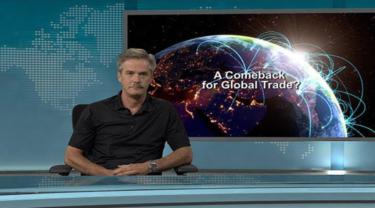It has been a dreary decade for international trade. From the heights in 2008, global trade flows plunged, staged a quick partial revival, then went into a holding pattern from then until now. In terms of trade intensity, we are far from what we used to be, and many are resigned to our current state as a permanent new normal. The debate on the future of trade has reached a fever pitch, and resulted in a lot of public acrimony. In the context of trade’s track record and the public backlash against its supporting architecture, is a comeback even possible?
Broadly-based disappointment in trade performance is understandable. After all, hopes were so high that in a world of static and even declining populations, the spread of trade would include masses of new consumers and increase productivity through globalization of supply chains. In fact, hopes were so fixed on trade as a solution to other fundamental weaknesses in the economy that they remained steadfast for years following the recession. It is only very recently that globalization has fallen afoul of the average voter – in effect, patience has run out.
Are the detractors right? Did we wrongfully place so much faith in trade and what it could accomplish? Were we wrong to think that the success experienced in the last cycle was an unlocking of centuries of hidden economic activity that was going to take a lot of time to fully realize? Maybe past progress was just an illusion, or maybe it was real, but stamped with a “best before” date that was a whole lot sooner than we thought. These doubts hold a lot of appeal among the disenfranchised in the current cycle.
For evidence, detractors point to the structural impediments that they believe globalization gave rise to. How about financial sector woes, exacerbated by the global reach of large institutions and the damaging domino effects they could perpetrate in the event of one or two key institutions collapsing? Or the excesses in capacity that were created in the last cycle, many of which are still being paid for? Add to that the public bailout of the economy, which increased government debt levels across the world to levels previously considered untenable.
These and other structural developments have eroded confidence in the construct of our system. But are we giving up on this architecture just as the ‘system’ appears to be healing itself? Our view has long been that the business cycle is poised to come to the rescue just as these arguments are intensifying. If so, there should be evidence out there that things are happening in the economy – positive things – that we have not seen since the Great Recession.
Thankfully there is a growing list of ‘new’ events that fill the bill. First, labour force inclusion. Throughout the post-recession period, whole chunks of the labour force in both the US and Europe have been bypassed due to insufficient growth. The latest data show that at long last, participation of these groups is rising again. Second, Western World confidence is back in ways thought unlikely just a year or two ago. Third, business investment seems finally to be responding to tightening industrial capacity conditions in what could prove to be a grand revival of building activity. A fourth and likely most significant development is that monetary tightening is now occurring on a much broader base, following the lead of the Fed in unwinding one of history’s greatest periods of ultra-loose policy – one of the clearest signs that economic conditions are finally hitting their stride.
If this is the case, then a fifth indication will not be far behind. If the economy is getting back on its feet for the first time in seven or more years, then with no radical change in economic architecture, we can safely assume that global trade intensity will start to recover some of the ground lost during the Great Recession. Capacity constraints and cost considerations will inevitably turn businesses in tighter growth zones to look for solutions outside of national borders in ways that brought great past benefit. In a good many emerging market locations, there is lots of idle capacity and a willingness to re-engage.
The bottom line?
It has taken a long time – far longer than usual – to achieve the preconditions for a normalization of growth. The extraordinary delay has made us all much more skittish about the sustainability of growth. Current momentum suggests that global trade will be the next beneficiary. Best to get ready for it!





